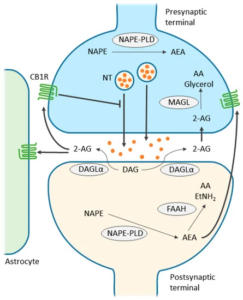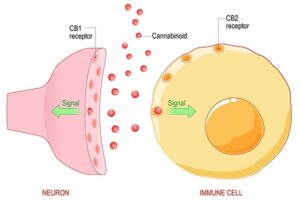NB Just a draft so far …
.. Receptors don’t exist because there’s a plant out there,” said Mechoulam in an interview at the 13th European Congress on Epileptology. “Receptors exist because we, through compounds made in our body, activate them. So we went looking for the endogenous compounds that activate the cannabinoid receptors.” Link below
Introduction to the Endocannabinoid System
” By comparing the genetics of cannabinoid receptors in different species, scientists estimate that the endocannabinoid system evolved in primitive animals over 600 million years ago” https://norml.org/marijuana/library/recent-medical-marijuana-research/introduction-to-the-endocannabinoid-system/
Evolutionary origins of the endocannabinoid system
https://pubmed.ncbi.nlm.nih.gov/16434153/
Cannabinoid Receptors and the Endocannabinoid System: Signaling and Function in the Central Nervous System
https://www.mdpi.com/1422-0067/19/3/833

Figure 1. Simplified scheme representing endocannabinoid retrograde signaling mediated synaptic transmission. Endocannabinoids are produced from postsynaptic terminals upon neuronal activation. As the two major endocannabinoids shown in the scheme, 2-arachidonolglycerol (2-AG) is biosynthesized from diacylglycerol (DAG) by diacylglycerol lipase-α (DAGLα), and anandamide (AEA) is synthesized from N-acyl-phosphatidylethanolamine (NAPE) by NAPE-specific phospholipase D (NAPE-PLD). As lipids, endocannabinoids, mainly 2-AG, readily cross the membrane and travel in a retrograde fashion to activate CB1Rs located in the presynaptic terminals. Activated CB1Rs will then inhibit neurotransmitter (NT) release through the suppression of calcium influx. 2-AG is also able to activate CB1Rs located in astrocytes, leading to the release of glutamate. Extra 2-AG in the synaptic cleft is taken up into the presynaptic terminals, via a yet unclear mechanism, and degraded to arachidonic acid (AA) and glycerol by monoacylglycerol lipase (MAGL). On the other hand, AEA, synthesized in postsynaptic terminal, activates intracellular CB1R and other non-CBR targets, such as the transient receptor potential cation channel subfamily V member 1 (TRPV1). Although endocannabinoid retrograde signaling is mainly mediated by 2-AG, AEA can activate presynaptic CB1Rs as well. Fatty acid amide hydrolase (FAAH) is primarily found in postsynaptic terminals and is responsible for degrading AEA to AA and ethanolamine (EtNH2). Although NAPE-PLD is expressed in presynaptic terminals in several brain regions, it is not clear yet whether AEA is responsible for anterograde signaling in the endocannabinoid system. Note that alternative routes exist for the metabolism of endocannabinoids, depending on the brain region and physiological conditions. Thin arrows indicate enzymatic process; thick arrows indicate translocation; blunted arrow indicates inhibition.
[The role of the endocannabinoid system in the regulation of endocrine function and in the control of energy balance in humans]
https://pubmed.ncbi.nlm.nih.gov/17369778/
“.. The endocannabinoid system has been recently recognized as an important modulatory system in the function of brain, endocrine, and immune tissues. It appears to play a very important regulatory role in the secretion of hormones related to reproductive functions and response to stress.”
Endocannabinoids in nervous system health and disease: the big picture in a nutshell
https://www.ncbi.nlm.nih.gov/pmc/articles/PMC3481537/
The endocannabinoid system: Essential and mysterious – Harvard Health
https://www.health.harvard.edu/blog/the-endocannabinoid-system-essential-and-mysterious-202108112569

“Many of us have heard of some of the transmitter systems within our bodies, such as the sympathetic nervous system, which gives us our fight-or-flight response. Fewer have heard of the more recently discovered endocannabinoid system (ECS), which is amazing when you consider that the ECS is critical for almost every aspect of our moment-to-moment functioning. The ECS regulates and controls many of our most critical bodily functions such as learning and memory, emotional processing, sleep, temperature control, pain control, inflammatory and immune responses, and eating. The ECS is currently at the center of renewed international research and drug development”
An introduction to the endogenous cannabinoid system – PMC
https://www.ncbi.nlm.nih.gov/pmc/articles/PMC4789136/

Fig 1: Overview of the localization of endocannabinoid system components at the synapse
Schematic of an inhibitory and excitatory terminal synapsing onto the dendritic shaft of a representative cortical principal neuron. Abbreviations: ABHD6, alpha/beta domain-containing hydrolase 6; CB1, CB1 cannabinoid receptor; CCK, cholecystokinin; COX-2, cyclooxygenase-2; DAGLα, diacylglycerol lipase α; M1, M1 muscarinic receptor; MAGL, monoacylglycerol lipase; mGluR5, metabotropic glutamate receptor 5; NAPE-PLD, N-arachidonoyl phosphatidyl ethanolamine-preferring phospholipase D; PLCβ, phospholipase C β. The increased number of CB1 receptors on the CCK/GABA terminal represents the higher density of CB1 receptors found on these axon terminals.
“… Interestingly, tonic activation of CB1 receptors by endocannabinoids is evident at several inhibitory synapses (98, 99), which may have important functional consequences when these synapses are exposed to THC. While DSE/DSI are primarily discussed in terms of inhibition of glutamate or GABA release, it is important to keep in mind that activation of CB1 receptors can also inhibit release of peptides, such as CCK often found in CB1 receptor positive terminals (100).”
The discovery of the endocannabinoid system: Centuries in the making
https://www.newswise.com/articles/the-discovery-of-the-endocannabinoid-system-centuries-in-the-making
“….Morphine was isolated from opium in the early 19th century, and cocaine was isolated from coca leaves in the middle of the 19th century. But by the turn of the 20th century, only one compound had been extracted from cannabis: cannabinol, a non-psychoactive metabolite of THC.
In the early 1940s, CBD (cannabidiol) and THC (tetrahydrocannabinol) were first extracted from cannabis. Twenty years later, their structures and stereochemistry were elucidated in Raphael Mechoulam’s laboratory. In 1965, Mechoulam’s lab synthesized both compounds. Since then, more than 100 cannabinoids have been catalogued.
Soon after the advances from the Mechoulam lab, cannabinoid research took off, as did the popularity of marijuana as a recreational drug. Because most research focused on the plant’s psychoactive properties, CBD—a non-psychoactive cannabinoid—was largely overlooked. However, several animal studies in the early 1970s showed that CBD had activity against epilepsy, and in 1980, a small clinical trial showed a reduction in seizure frequency in 7 of 8 patients with epilepsy taking CBD, compared with 1 of 8 taking placebo. At the same time, a flurry of studies in the 1970s and early 1980s found evidence that CBD had anxiolytic and anti-psychotic effects. Still, the main focus rested on THC.
Though the human opiate receptor had been discovered in 1973, the idea that there could be cannabinoid receptors wasn’t seriously considered at first.
… Meet the receptors
CB1, encoded by the gene CNR1, consists of 472 amino acids; the rodent form of the receptor is 98% identical. CB1 binds THC and is thought to produce the “high” of marijuana; several variations of the CNR1 gene are associated with marijuana dependence.
CB1 is one of the most abundant G-protein-coupled receptors in the central nervous system. It’s found at particularly high levels in the neocortex, hippocampus, basal ganglia, cerebellum and brainstem. CB1 also is found on peripheral nerve terminals and some other areas, such as the testis, eye, vascular endothelium and spleen.
CB2, encoded by the gene CNR2, consists of 360 amino acids. The rodent form of CB2 is about 80% identical. CB2 receptors occur mainly on immune cells, but also have been detected in the central nervous system, where they are associated with inflammation, addiction and synaptic plasticity.
.. Receptors don’t exist because there’s a plant out there,” said Mechoulam in an interview at the 13th European Congress on Epileptology. “Receptors exist because we, through compounds made in our body, activate them. So we went looking for the endogenous compounds that activate the cannabinoid receptors.”
Some links
Coevolution between cannabinoid receptors and endocannabinoid ligands
https://pubmed.ncbi.nlm.nih.gov/17537592/
Phylogenomic and chemotaxonomic analysis of the endocannabinoid system
https://pubmed.ncbi.nlm.nih.gov/15063097/
Endocannabinoida systemet – Wikipedia
https://sv.wikipedia.org/wiki/Endocannabinoida_systemet
Endocannabinoid system – Wikipedia
https://en.wikipedia.org/wiki/Endocannabinoid_system
More is to come
